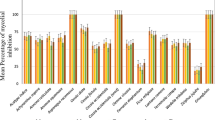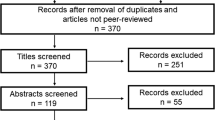Abstract
The increasing incidence of fungal infections and antifungal resistance has prompted the search for novel antifungal drugs and alternative agents. We explored the antifungal activity of Myrtus communis essential oil (EO) against Malassezia sp. isolated from the skin of patients with pityriasis versicolor. These broad-spectrum antimicrobial activities of M. communis EO and its potent inhibiting activity on Malassezia growth deserve further research with aim to considerate this EO as candidate for topical use in treatment of skin diseases.
Similar content being viewed by others
Change history
02 January 2018
The original version of this article unfortunately contained two mistakes in authors’ names.
References
Gaitanis G, Velegraki A, Mayser P, Bassukas ID. Skin diseases associated with Malassezia yeasts: facts and controversies. Clin Dermatol. 2013;31:455–63.
Velegraki A, Cafarchia C, Gaitanis G, Iatta R, Boekhout T. Malassezia infections in humans and animals: pathophysiology, detection, and treatment. PLoS Pathog. 2015;11:e1004523.
Sharma A, Rabha D, Ahmed G. In vitro antifungal susceptibility of Malassezia isolates from pityriasis versicolor lesions. Indian J Dermatol Venereol Leprol. 2017;83:249–51.
Pekmezovic M, Aleksic I, Barac A, Arsic-Arsenijevic V, Vasiljevic B, Nikodinovic-Runic J, Senerovic L. Prevention of polymicrobial biofilms composed of Pseudomonas aeruginosa and pathogenic fungi by essential oils from selected Citrus species. Pathog Dis. 2016;. https://doi.org/10.1093/femspd/ftw102.
Ghasemi Pirbalouti A, Izadi A, Malek Poor F, Hamedi B. Chemical composition, antioxidant and antibacterial activities of essential oils from Ferulago angulata. Pharm Biol. 2016;54:2515–20.
Kordali S, Usanmaz A, Cakir A, Komaki A, Ercisli S. Antifungal and herbicidal effects of fruit essential oils of four Myrtus communis genotypes. Chem Biodivers. 2016;13:77–84.
Cannas S, Molicotti P, Ruggeri M, Cubeddu M, Sanguinetti M, Marongiu B, Zanetti S. Antimycotic activity of Myrtus communis L. towards Candida spp. from isolates. J Infect Dev Ctries. 2013;7:295–8.
Deriu A, Branca G, Molicotti P, Pintore G, Chessa M, Tirillini B, Paglietti B, Mura A, Sechi LA, Fadda G, Zanetti S. In vitro activity of essential oil of Myrtus communis L. against Helicobacter pylori. Int J Antimicrob Agents. 2007;30:562–3.
Rodriquez-Tudela IL, Donnelly JP, Arendrup MC, Arikan S, Barchiesi F, Bille J, et al. EUCAST technical note on the method for the determination of broth dilution minimum inhibitory concentrations of antifungal agents for conidia-forming moulds. Clin Microbiol Infect. 2008;14:982–4.
Aleksic V, Knezevic P. Antimicrobial and antioxidative activity of extracts and essential oils of Myrtus communis L. Microbiol Res. 2014;169:240–54.
Acknowledgements
The paper has been published with the support of the Projects of Ministry of Education, Science and Technology of the Republic of Serbia (Nos. III45005 and OI 175025).
Author information
Authors and Affiliations
Corresponding author
Ethics declarations
Conflict of interest
There is no financial or any other conflict of interest.
Additional information
The original version of this article was revised: The original version of this article unfortunately contained two mistakes in authors’ names.
The correct names of the seventh and ninth authors are Ema Aleksic and Natasa Nikolic, respectively.
A correction to this article is available online at https://doi.org/10.1007/s15010-017-1104-2.
Rights and permissions
About this article
Cite this article
Barac, A., Donadu, M., Usai, D. et al. Antifungal activity of Myrtus communis against Malassezia sp. isolated from the skin of patients with pityriasis versicolor. Infection 46, 253–257 (2018). https://doi.org/10.1007/s15010-017-1102-4
Received:
Accepted:
Published:
Issue Date:
DOI: https://doi.org/10.1007/s15010-017-1102-4




